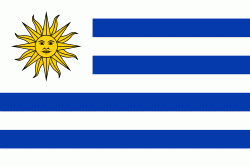Santa Bernardina International Airport (Durazno)
Santa Bernardina International Airport (Aeropuerto Internacional Santa Bernardina) is a military and general aviation airport serving Durazno, capital of the Durazno Department of Uruguay.
The facilities are shared with the '''Tte. 2° Mario W. Parallada Air Base''' of the Uruguayan Air Force.
The airport is 3 km across the Yí River, northeast from downtown Durazno. The Durazno VOR-DME (Ident: DUR) is located on the field. Several non-directional beacons are located around the airport.
Tte. 2° Mario W. Parallada Air Base is a base of the Uruguayan Air Force that shares facilities at the Santa Bernardina International Airport.
Air Brigade No. 2 is stationed at the base. The brigade has three operating squadrons:
* No. 2 Squadron flies 8 Cessna A-37 Dragonfly aircraft in fighter and ground attack missions.
* Advanced Flight Squadron flies 5 Pilatus PC-7 training aircraft.
* Enlace Squadron flies 4 Cessna 206 and 1 Cessna 210 aircraft in utility and liaison roles.
The facilities are shared with the '''Tte. 2° Mario W. Parallada Air Base''' of the Uruguayan Air Force.
The airport is 3 km across the Yí River, northeast from downtown Durazno. The Durazno VOR-DME (Ident: DUR) is located on the field. Several non-directional beacons are located around the airport.
Tte. 2° Mario W. Parallada Air Base is a base of the Uruguayan Air Force that shares facilities at the Santa Bernardina International Airport.
Air Brigade No. 2 is stationed at the base. The brigade has three operating squadrons:
* No. 2 Squadron flies 8 Cessna A-37 Dragonfly aircraft in fighter and ground attack missions.
* Advanced Flight Squadron flies 5 Pilatus PC-7 training aircraft.
* Enlace Squadron flies 4 Cessna 206 and 1 Cessna 210 aircraft in utility and liaison roles.
| IATA Code | DZO | ICAO Code | SUDU | FAA Code | |
|---|---|---|---|---|---|
| Telephone | Fax | ||||
| Home page |
Map - Santa Bernardina International Airport (Durazno)
Map
Country - Uruguay
 |
 |
| Flag of Uruguay | |
The area that became Uruguay was first inhabited by groups of hunter–gatherers 13,000 years ago. The predominant tribe at the moment of the arrival of Europeans was the Charrúa people, when the Portuguese first established Colónia do Sacramento in 1680; Uruguay was colonized by Europeans late relative to neighboring countries. The Spanish founded Montevideo as a military stronghold in the early 18th century because of the competing claims over the region. Uruguay won its independence between 1811 and 1828, following a four-way struggle between Portugal and Spain, and later Argentina and Brazil. It remained subject to foreign influence and intervention throughout the 19th century, with the military playing a recurring role in domestic politics. A series of economic crises and the political repression against left-wing guerrilla activity in the late 1960s and early 1970s put an end to a democratic period that had begun in the early 20th century, culminating in the 1973 coup d'état, which established a civic-military dictatorship. The military government persecuted leftists, socialists, and political opponents, resulting in deaths and numerous instances of torture by the military; the military relinquished power to a civilian government in 1985. Uruguay is today a democratic constitutional republic, with a president who serves as both head of state and head of government.
Currency / Language
| ISO | Currency | Symbol | Significant figures |
|---|---|---|---|
| UYU | Uruguayan peso | $ | 2 |
| ISO | Language |
|---|---|
| ES | Spanish language |















